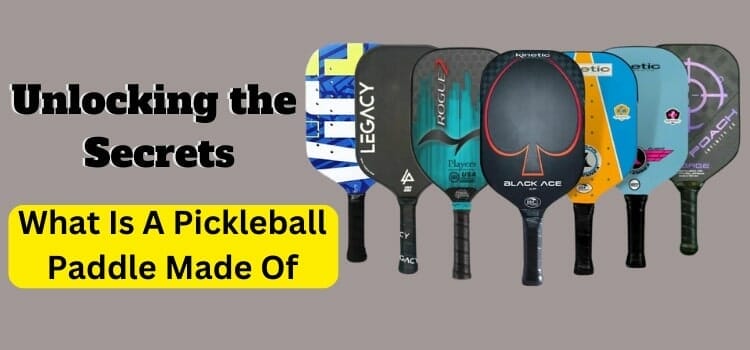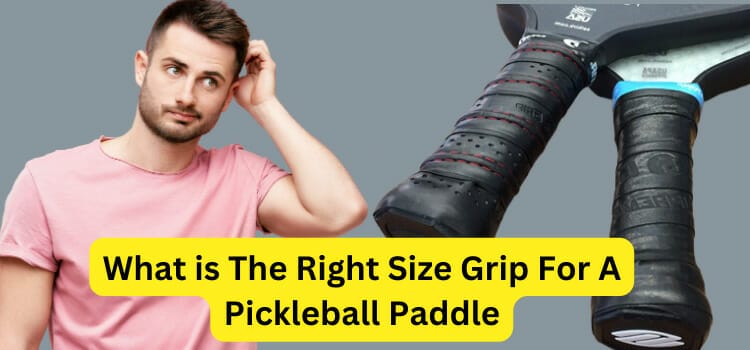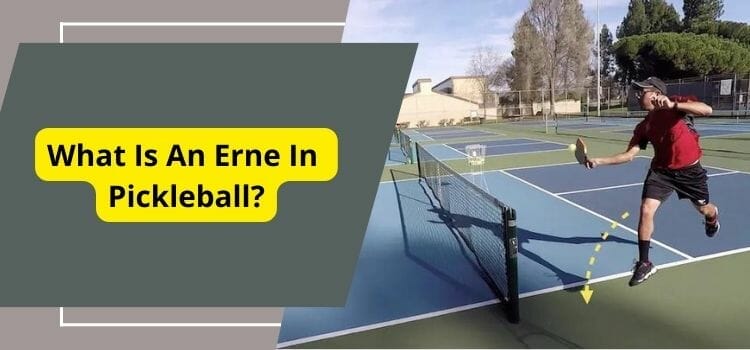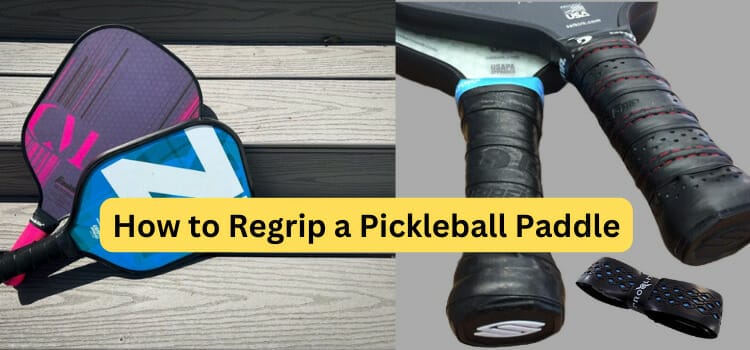What Is A Pickleball Paddle Made Of Unlocking the Secrets

Are you curious about what exactly goes into making a pickleball paddle? Well, you’ve come to the right place!
A pickleball paddle is crafted from a blend of high-performance materials, such as carbon fiber, graphite, wood, aluminum, or composite, designed to deliver power, control, and durability for an exhilarating gameplay experience.
Here I’ll dive deep into the world of pickleball paddles and explore the different materials that are used to create these essential pieces of equipment. Whether you’re a seasoned player or just starting out, understanding the construction and composition of your paddle can greatly impact your game. So grab your favorite beverage and get ready to learn all about what makes a pickleball paddle tick!
What Is A Pickleball Paddle Made Of – Different Materials Used
When it comes to pickleball paddles, the choice of materials goes far beyond aesthetics. Each material presents a world of possibilities, offering distinct advantages that can elevate your performance on the court. Whether you crave lightning-fast maneuverability, unyielding power, or precise control, understanding the unique characteristics of these paddle materials is key to finding the perfect match for your playing style.
1. Carbon Paddle
Carbon pickleball paddles have gained popularity among players due to their lightweight and durable nature. These paddles are made using a combination of carbon fiber and other materials, resulting in a strong yet flexible paddle.
The use of carbon fibers in the construction of these paddles provides several benefits. It allows for better power and control during gameplay. The stiffness of carbon fiber enhances the transfer of energy from player to ball, resulting in powerful shots that can be controlled with precision.
Carbon pickleball paddles offer improved durability. The strength and resilience of carbon fibers make these paddles resistant to dings, scratches, and general wear and tear. This means they can withstand intense gameplay without losing their performance capabilities over time.
The lightweight nature of carbon pickleball paddles makes them easy to maneuver on the court. Players can swing faster and react quickly to shots due to the reduced weight, allowing for more agility during gameplay.
2. Wooden Paddle
Wooden paddles have a long history in the world of pickleball. These traditional paddles were among the first to be used when the sport was created. They are known for their classic look and feel, which some players still prefer today.
One of the main advantages of wooden paddles is their durability. The solid wood construction makes them less prone to cracking or breaking during intense gameplay. Additionally, wooden paddles tend to be heavier than other materials, which can provide more power behind shots.
However, there are also some drawbacks to using a wooden paddle. One major concern is that they can absorb moisture and become warped over time if not properly cared for. This can affect performance and make it difficult to control shots accurately.
In terms of playability, wooden paddles offer a softer touch compared to other materials like graphite or composite. Some players enjoy this softer feel as it allows for better control and finesse on the court.
3. Composite Paddle
Composite paddles are a popular choice among pickleball players. These paddles are made from a combination of materials, typically fiberglass and polymer or Nomex. The use of different materials in the construction of composite paddles allows for a unique blend of power, control, and durability.
One of the key advantages of composite paddles is their versatility. They offer a balanced combination of power and control, making them suitable for players with varying playing styles. The fiberglass surface provides excellent pop on the ball while offering good touch for precise shots.
Another benefit is their durability. Composite paddles are known to be more resistant to dings and scratches compared to other paddle types. This makes them an ideal choice for players who frequently play outdoors or participate in competitive matches where paddle contact with the court surface may occur.
Composite paddles often have a larger sweet spot than other paddle materials, which can help improve shot consistency and reduce mishits.
4. Aluminum Paddle
Aluminum paddles are a popular choice among pickleball players due to their durability and lightweight nature. These paddles are made from an aluminum composite material, which combines the strength of aluminum with other elements to create a sturdy and reliable paddle.
One of the key advantages of aluminum paddles is their ability to withstand heavy usage without succumbing to wear and tear. This makes them ideal for competitive players who play frequently or for those who tend to be rough on their equipment.
Aluminum paddles offer great control and precision during gameplay. The rigid construction allows players to manipulate the ball with accuracy, making it easier to execute shots such as dinks and volleys.
However, one drawback of aluminum paddles is that they can transmit more vibrations compared to other materials like graphite or composite. Some players may find this uncomfortable or tiring over extended periods of play.
5. Graphite Paddles
Graphite paddles have gained immense popularity in the world of pickleball. These paddles are known for their lightweight yet sturdy construction, making them a favorite among players of all skill levels.
One of the main advantages of graphite paddles is their excellent control and maneuverability on the court. The graphite material provides a responsive feel, allowing players to make precise shots and quick adjustments during gameplay.
To control, graphite paddles also offer great power. The combination of the paddle’s weight distribution and the stiffness of the graphite material allows players to generate impressive ball speed without sacrificing control or accuracy.
Graphite paddles excel in durability, thanks to the material’s strength and resistance to wear and tear, ensuring they withstand countless intense matches. Moreover, their honeycomb or Nomex core further enhances power and control, damping vibrations while delivering a solid hitting surface for consistent performance.
The Importance Of Paddle Material Thickness
The thickness of a pickleball paddle’s material is an important factor to consider when choosing the right paddle for your game. The thickness directly affects the weight, power, and control you can achieve on the court.
- A thicker paddle material generally translates to more power and less control. This is because a thicker surface creates a larger sweet spot, allowing for more powerful shots. However, it may also make it harder to maneuver and finesse the ball with precision.
- On the other hand, a thinner paddle material provides better touch and control but sacrifices some power. This allows players to have more finesse in their shots and place them precisely where they want on the court.
- It’s crucial to find a balance that suits your playing style and skill level. Beginners might benefit from starting with a slightly thicker paddle as it provides forgiveness and easier shot-making capabilities. Advanced players may prefer thinner paddles that allow for greater control over their shots.
Finding your ideal paddle thickness requires experimentation and understanding how different materials affect your play style. So don’t be afraid to try out various options until you find what works best for you!
What Are Paddle Cores And How Do They Affect Paddles?
The core of a pickleball paddle is the material that sits between the paddle surface and the handle. It is responsible for providing the paddle with its desired level of stiffness, weight, and feel. It also influences the paddle’s overall performance, including the amount of power and control it provides.
There are two main types of paddle cores:
- Polymer cores: These are the most common type of core. They are made of a lightweight, flexible material that absorbs shock well. This makes them a good choice for players who want a paddle with a soft feel and good control.
- Nomex cores: These cores are made of a high-performance material that is stronger and more durable than polymer cores. They also provide more power, but they can be a bit less forgiving on off-center hits.
The thickness of the core also affects the performance of the paddle. Thicker cores provide more power, but they can also make the paddle feel heavier and less maneuverable. Thinner cores provide more control, but they can also make the paddle feel less powerful.
Here is a table that summarizes the key differences between polymer and Nomex cores:
| Feature | Polymer Core | Nomex Core |
| Material | Lightweight, flexible | Strong, durable |
| Feel | Soft, forgiving | Firm, responsive |
| Power | Less powerful | More powerful |
| Control | More control | Less control |
| Weight | Lighter | Heavier |
| Maneuverability | More maneuverable | Less maneuverable |
Why Is Paddle Weight Important Regarding Material?
Paddle weight plays a crucial role in determining the performance and feel of a pickleball paddle. When it comes to paddling materials, the weight can vary significantly based on the material used.
Lightweight paddles are generally preferred by players who value speed and maneuverability. These paddles allow for quick reaction times and swift movements on the court. They are also less fatiguing to use over long periods of play.
On the other hand, heavier paddles provide more power and stability during shots. The additional weight helps generate greater momentum, allowing players to hit harder shots with more control. However, they may require more effort to swing and can lead to quicker fatigue.
The choice between a lightweight or heavyweight paddle ultimately depends on personal preference and playing style. Some players might prefer a lighter option for finesse shots and quick returns, while others might opt for a heavier paddle for added power in their game.
Finding the right paddle weight involves trial and error as every player has different preferences and needs on the court. It’s about finding that sweet spot where you feel comfortable swinging your pickleball paddle confidently without compromising your performance!
Choosing The Right Paddle Based On Material
Choosing the right paddle based on material is a crucial decision for any pickleball player. The material of the paddle can greatly impact your performance and overall playing experience. To make the best choice, consider the following factors:
- Consider your playing style. If you are a power player, you will want a paddle that is lightweight and stiff. If you are a control player, you will want a paddle that is heavier and more forgiving.
- Consider your physical strength. If you are not very strong, you will want a lighter paddle. If you are strong, you may be able to handle a heavier paddle.
- Consider your budget. Paddles made from different materials can vary in price. Wood paddles are typically the most affordable, while graphite paddles are the most expensive.
- Try out different paddles. The best way to find the right paddle for you is to try out different paddles and see what feels comfortable to you.
Consider your playing style, physical strength, preferences, and budget constraints when choosing the right paddle based on material. A paddle that aligns with your needs can significantly elevate your overall pickleball experience and performance on the court.
Conclusion
As you can see, the material of a pickleball paddle plays a crucial role in determining its performance on the court. Different materials offer unique characteristics that cater to different playing styles and preferences.
When selecting a paddle based on material, consider your skill level, playing style, and personal preferences. Try out different types of paddles if possible to determine which one feels most comfortable in your hand and suits your gameplay needs.
Understanding paddle thickness, core construction, and weight will enhance your gameplay. Armed with this knowledge, confidently select the right paddle to elevate your skills and aim for victory on the pickleball court!
FAQS
Q. What is the advantage of using a carbon fiber pickleball paddle?
A. Carbon fiber paddles offer lightweight and durable construction, providing players with excellent control and maneuverability on the court. They are favored for their power and responsiveness, making them a top choice among competitive players.
Q. Are wooden pickleball paddles still popular?
A. Yes, wooden paddles have a long history in pickleball and remain a favorite among traditionalists. They provide a classic feel and sound when hitting the ball while offering good touch and control.
Q. Why are aluminum paddles a popular choice?
A. Aluminum paddles offer durability while remaining relatively lightweight. They are often favored by recreational players looking for a balance between performance and affordability.
Q. Does paddle weight matter?
A. Paddle weight is essential for determining the feel and performance of the paddle. Lightweight paddles offer speed and maneuverability, while heavier paddles provide more power and stability during shots.





